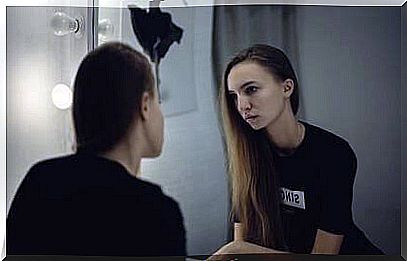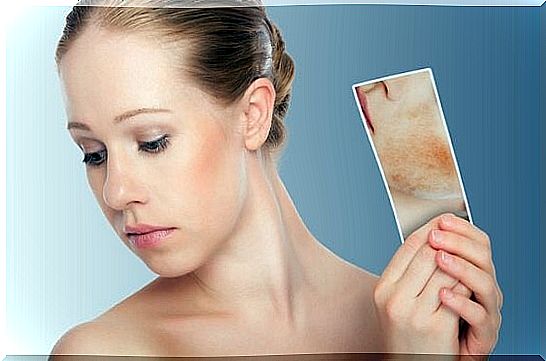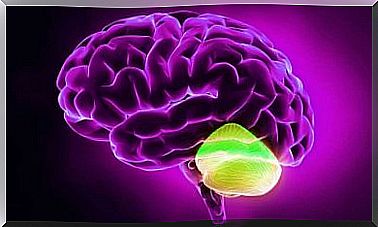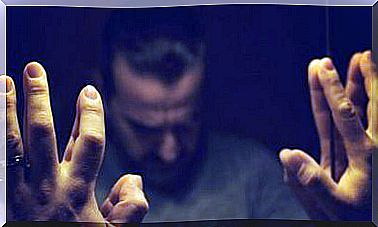Mirror Exposure Therapy: What Does It Consist Of?

Mirror exposure therapy is a psychological technique for the body and soul. It helps to treat negative body image, reduce anxiety, untie the knots that intensify depression. Definitely, we are facing a very effective strategy for loving and reconciling with the person who is reflected in the mirror’s surface.
It may seem strange, but there are many women (and men as well) who, upon seeing their own image, feel an uncomfortable and unpleasant sensation. Some people see fat accumulation where there isn’t. Others only see wrinkles, physical defects, ugliness and contempt. Almost without knowing how, the mirror becomes a space of torture that ends up undermining its own identity and self-esteem.
These psychological realities often manifest themselves in clinical entities such as eating disorders or dysmorphic disorders. Thus, while a healthy person observes their image with acceptance and pride for every detail of their body, patients with these pathologies feel very bad for details that are not real. All this brings a very high suffering.
In those cases where body dissatisfaction is so devastating, the use of mirror exposure therapy, along with the management of negative emotions and thoughts, has been found to be very effective. Let’s see more information below.

Mirror exposure therapy: what is it?
Mirror exposure therapy is highly effective. However, specialists still do not understand exactly the mechanisms through which the patient is finally able to accept his own body image. This technique uses several therapeutic tools that can vary depending on the needs of each patient.
- The University of Maastricht conducted a study in 2016 in which it sought to know about these mechanisms that facilitated improvement in patients with bulimia or low physical acceptance in just over a month. One thing they could see was that working on assignments, biases, and the emotional aspect was very productive.
- The University of Grenada also published an interesting paper in the Journal of Behavior Therapy and Experimental Psychiatry, in which they scientifically demonstrated how patients showed lower levels of cortisol after mirror exposure therapy.
Both researches, without a doubt, help to understand the processes of this technique much more. They are as follows:
The Three Techniques of Mirror Exposure Therapy
When performing mirror exposure therapy, we usually use two techniques:
- Guided exposure: in this case, the specialized psychologist guides the patient to describe her body while observing herself in the mirror. You should do this neutrally and objectively, as if you were describing a drawing.
- Pure exposure: in this case, the person freely and authentically expresses all the feelings he experiences when seeing his body. Here, as expected, they will feel uncomfortable revealing what they perceive in themselves as ugly, unpleasant or even misshapen. However, this part is very necessary for the therapeutic process itself.

Authors Griffen, TC, Naumann, E., and Hildebrandt, T. (2018) state that these two techniques are not always effective for all patients. In these situations, a third strategy is used that always ends up facilitating the objectives:
- Mirror exposure with a positive focus. This tool helps the person to reduce their distress. The therapist guides the patient to talk about those areas of the body that please him most. Please use positive language. If the person doesn’t see anything and doesn’t appreciate anything attractive and positive about their body, the professional can help. You can do this with phrases like: ‘I think your face is beautiful, your skin tone is healthy and delicate’, ‘your hands are attractive too’…
Why Mirror Exposure Therapy Works
We’ve talked about this a bit before. Many people wonder how it is possible that, at the end of 6 sessions, patients already have a clear improvement . It is common for stress to be reduced, for self-esteem to improve, and for the person to come to appreciate the often more problematic areas of their own body. If this is possible – and there is an evident success rate in mirror exposure therapy – the reasons are as follows:
The 4 Pillars of Effectiveness
- Modification of self-interpretations: A person with a dysmorphic or eating disorder relates any adverse situation in their day to their body image. If you make a mistake, if someone says no as an answer, if someone generates a hurt, etc… The person attributes everything solely and exclusively to their physical condition. With this therapy, these interpretations are reduced.
- Attention Bias: If someone has a thin nose, thick ankles or broad shoulders, too little chest, too many freckles, etc., their attention bias causes only these areas to be seen, and also interpreted as defects. With this clinical focus, this bias weakens.
- Reduction of fear and anxiety: Like all therapy based on exposure to the focus of anxiety, sooner or later we can reduce negative emotions by creating more positive relationships with this problematic stimulus: the physical itself.
- The fourth pillar of mirror exposure therapy is called cognitive recycling: this strategy makes it easier for the patient to see themselves differently and stop passing their image through a filter of negativity and rejection. It helps to recycle and heal the vision so that you can see yourself with greater respect and, above all, with appreciation.
As we can intuit, this technique may be the answer many people need. Mainly for those who are at a time when they have not yet developed any eating disorder, but begin to feel a certain rejection by the image that the mirror reflects. At that point, it would be highly recommended to seek help from a professional. Think about it.









